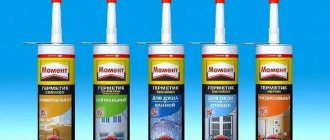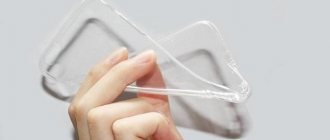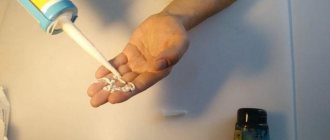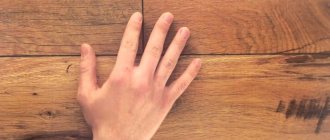Sealant is a substance made using silicone rubbers. It is widely used when performing repair work. Let's consider how to remove silicone sealant, which is especially important due to the properties of this material. Learn effective cleaning methods for various products and surfaces.
Assortment of sealants Source mr-build.ru
Possible cleaning methods
In order not to worry about how to wash silicone sealant, it is recommended to remove excess material before it dries. The “fresh” (not hardened) mixture can be easily washed off with a regular sponge. The use of rags is allowed.
Once the silicone hardens, it is quite difficult to remove. This is especially true for embossed materials (various types of tiles). If the technology has not been violated, silicone sealant adheres to them very strongly.
If you plan to reapply the mixture to the surface, it is important to pay a lot of attention to removing the existing layer. This necessity is explained by the lack of adhesion between silicone molecules, which have already undergone polymerization and have just begun this process.
It is also important to thoroughly clean the surface of any silicone that has gone beyond the permissible limits during application. Even transparent material becomes dirty and dark during use, which disrupts the appearance of finishes, plumbing fixtures and other products.
Silicone affected by mold Source ytimg.com
Mechanical methods
Before removing silicone sealant, the surface should be mechanically treated. They are trying to get rid of as much material as possible. Mechanical cleaning is carried out using any devices. It is desirable that they be sharp and thin. The most suitable tools are:
- Metal spatula . It copes well with removing contaminants on non-relief surfaces formed from different materials. An important requirement is that the working edge of the spatula must be smooth. Otherwise, the surface being treated may be scratched.
Metal spatula Source dobrostroy.rf
- Razor blade . Must be used extremely carefully. If used carelessly, there is a risk of injury and leaving scratches on the surface being treated.
- Knife . It is better to use a special wallpaper. Using a knife is convenient for removing large accumulations of hardened mixture.
Wallpaper knife Source prom.st
- Bank card . It is formed from soft plastic, so it is not capable of scratching or damaging the surface. But the card will not cope with serious contamination. It is recommended to use it after using one of the chemicals.
After preliminary rough treatment, it is recommended to continue cleaning using any abrasive. Pumice stone, hard sponge or salt will do. You need to rub it carefully to avoid scratches. For glass or ceramics, it is better to use fine salt.
Salt is suitable for cleaning Source yandex.net
See also: Catalog of companies that specialize in paints, protective and finishing materials
Chemical methods
To determine how to clean silicone sealant, you need to know its exact composition. Conventional construction silicone most often has an acid base. This is evidenced by the cloying smell of vinegar. It appears immediately after applying the mixture and remains until it hardens. To clean surfaces from this type of silicone, use concentrated acetic acid 70%.
In addition to acidic, sealants can also have another neutral base:
- Oxide . Can be removed using any solvent or purified gasoline.
- Alcohol . For cleaning, it is recommended to use ethanol (technical, food grade).
- Amide . It is removed in the same way as the oxide mixture.
A variety of chemicals Source avtoelektrik-info.ru
Before choosing how to remove silicone sealant, you need to understand that some materials can only be processed mechanically. This applies to polyurethane mixtures. Once polymerization is complete, this material can only be removed with a very sharp, thin blade. If the polyurethane mixture has not yet completely hardened, try to partially wash it off with a solvent.
When using any silicone sealant remover, you must consider the type of surface being treated. Contact of varnished or painted material with solvents is prohibited. There is also no need to clean glass with gasoline. This will lead to the formation of divorces. It is impossible to get rid of them in the future.
Industrial products
The most popular cleaners:
- H.G. _ The product is suitable for removing stubborn stains. It has a pleasant smell and does not spoil the appearance of the products.
Industrial cleaner Source ozone.ru
- Tytan . Contains acids. The product shows good results on surfaces with depressions. The advantage is the absence of a pungent odor.
- XADO Mottec . The product is made on an alcohol basis. Great for acrylic. After drying, it leaves no traces.
- Soudal . Differs in hydrocarbon base. It is recommended to apply only after complete removal of moisture. It is advisable to test the product before use, as it can leave greasy marks.
Safety precautions when working with the cleaner
It is important to organize the work process correctly. When working with cutting, sharp tools, wear thick rubber gloves .
The cuts are made carefully, slowly, removing the frozen mass millimeter by millimeter. When working with aggressive solvents and chemicals, protect the skin of your hands with special thick construction gloves that are resistant to acids.
Ensure free air circulation in the room by opening windows and doors wide.
To protect your eyes from exposure to acids and harmful fumes, wear plastic goggles. The respiratory tract will not be affected if you purchase a respirator or disposable protective mask.
Methods for cleaning different surfaces
To determine how to remove silicone sealant, you need to try and combine different methods. Specific recommendations depend on the type of coating being treated.
Removing unusable sealant Source prorab.help
Bath
When choosing how to clean the sealant on the bathtub, you can follow the following tips:
- The layer of hardened mixture must be carefully pryed off with a sharp blade.
- Use your hands to try to completely remove the material.
- The surface should be wiped with a damp cloth soaked in salt of minimal grain size.
- If there are traces of the sealing agent left on the bathtub, they can be washed off with vinegar or solvent.
If the silicone-containing substance has not yet hardened, there is no need to perform these manipulations. The mixture that has contaminated the surface of the bath can be easily removed with a solvent.
Removing silicone-containing products from the bathtub Source kak-otteret.ru
Tiles on the wall
To understand how to wash silicone, you need to read the following instructions:
- It is recommended to remove large pieces of silicone using a thin object.
- A washcloth is soaked in a solvent and the dirty tiles are treated. There must be a lot of liquid so that it can be “absorbed” into the hardened mixture.
- After 10 minutes, remaining silicone can be removed with a hard cloth soaked in solvent.
- At the final stage, it is recommended to wash the tiles using a soap solution.
How not to cause harm
Before starting the tile cleaning procedure, weigh the pros and cons.
It is important not to damage the surface of the tile or scratch it.
It is better to check the operation of the tool and the effect of solvents on an invisible area of the cladding. This will ensure that the tiles will not be damaged.
Cleaning is a labor-intensive process, so in order not to resort to it, it is important to clearly apply the sealant to the seams, using masking tape or construction tape as a limiter.
Special attachments placed on the spout of a can of silicone prevent it from splashing and allow you to process joints evenly.
Briefly about the main thing
It is quite difficult to remove hardened sealant from any surface. Therefore, it is recommended to remove traces of the mixture before completing its polymerization.
Mechanical techniques and various chemicals are used to remove silicone-containing compounds. It is recommended to initially clean the surface with a wallpaper knife or spatula. After removing large pieces of material, you can move on to final cleaning using ethanol, solvents and other substances.
There are industrial products on sale that effectively deal with stains from silicone rubbers. They are used exactly according to the instructions after preliminary testing.
Purpose of the sealant
This is a plastic material that has a high degree of elongation and has high waterproofing properties. It is necessary for sealing seams and joints, after which liquid will not get under them.
The substance provides reliable waterproofing between the floor and the toilet, wall and sink. The sealant quickly sets, adheres to surfaces, and hardens.
Also, a plastic substance is necessary to seal the joints between tiles and a bathtub or kitchen sink.
It is applied in a thin layer, filling the seam. Use sealant to eliminate gaps in the bathroom and kitchen.
Fast curing is a good characteristic for a sealant, but not when it needs to be removed from the tile surface. This task is a real problem, especially if the substance has hardened and dried out.
Removing fresh material
It is much easier to remove a freshly applied layer when the setting process is not complete and the connection does not yet have high-strength characteristics. First they try to wipe the area with a dry cloth, the sealant simply twists and comes off. If the method does not help, resort to rubbing with an eraser. As a rule, these simple manipulations help. If they do not work, then you can sprinkle salt on a rag and try to wipe the surface with it, or use the hard side of a sponge.
It is much easier to remove a freshly applied layer when the setting process is not complete and the connection does not yet have high-strength characteristics.
The article described effective methods on how to clean tiles from silicone sealant. If you follow the rules without violating the principles of work, you will be able to remove the layer completely without leaving any marks on the coating.
Home methods
- Acidic. They contain acid, usually acetic acid. This not only gives them an easily recognizable smell, but also determines their very low cost. The solutions are effective, harden quickly, and have good adhesion. The main disadvantage is incompatibility with metals, cement-containing coatings and stone. The acid contained in the paste destroys them.
- Neutral. More expensive materials that use alcohols or amines. Thanks to this, they are absolutely safe for any coating and are used everywhere. They are characterized by high efficiency, good adhesion and durability. The polymerization process of such solutions is slower, so they need about a day to harden.
The difficulty of removal depends on several factors. Among them:
When to delete
- The sealant is not applied correctly, resulting in no protection against moisture penetration. Then the carelessly applied layer is removed, and the seam is filled with sealant again.
- Over time, the sealing layer wears out and deteriorates, and it may change color due to fading or severe contamination. The seam may crack, which will significantly impair its moisture-proof characteristics. The damaged layer must be removed immediately.
- Even if the sealant contains antiseptic additives, during prolonged use in conditions of high humidity, for example, in a bathroom, microorganisms can multiply on the surface, causing mold to quickly appear. The contaminated layer must be removed as quickly as possible, since mold that multiplies in dampness can worsen the well-being of apartment residents.
- During repairs, sealant accidentally ends up on inappropriate surfaces.
Peculiarities
Silicone is a unique substance available for use in sealing. It is non-toxic, so it is often used to seal tile joints in the bathroom, kitchen, swimming pool, refrigerators and ovens. Over time, it can still turn yellow, crack, and its sealing properties are impaired. Then you need to carry out a planned replacement of the material, and for this you will have to remove the old one. This material is also used as an adhesive base for joining different parts.
The difficulty of removal lies in the ability of silicone to penetrate deep into the cracks and pores of rough surfaces. The width of the silicone-coated surface can also complicate the work. Therefore, you will have to clean off the sealant very carefully.
As for the composition of the mixture, in addition to the main substance, it contains various types of additives. Bactericidal compounds that prevent the penetration and development of microorganisms in the joints of kitchen or toilet tiles, plus various solvents that give the substance elastic and sticky properties.
Due to the solvent, the sealant has a recognizable pungent odor, so chemicals to remove the material are used with extreme caution.
There are two groups of silicone sealants on the market - one-component and two-component.
They are sold in ordinary plastic or polyethylene tubes. They harden when the solvent in the mixture evaporates, but only thin strokes can dry completely in due time. Most adhesives on the counter are one-component, which in turn can be acidic or neutral:
- Acidic - have a distinct smell of acetic acid, are very inexpensive and effective.
- Neutral - practically odorless, more resistant to temperature changes, and their price is noticeably higher.
The purpose of the adhesive-sealant is usually indicated on the packaging: automotive, construction, special and others. Two-component (compounds) harden when interacting with a kind of catalyst. They are rarely found in regular stores due to the fact that they are used mainly for industrial purposes. Completely hardens in any quantity and on any surface.
Precautionary measures
When performing cleaning, be sure to follow the following precautions:
- Hands must be protected with protective equipment, and the room must be constantly ventilated.
- Spray cleaners are sprayed in a circular pattern, which increases the likelihood of the product getting on the skin and clean tiles or other surfaces. To prevent unnecessary changes, clean areas are covered.
- Do not work with products near open fire or heat devices.
- Study the instructions for use provided on the packaging.
- After using chemicals, wash your hands thoroughly with detergents.
- Particular care is taken with sharp objects used when cleaning sealant. High probability of a cut.
Tips and tricks
In hardware stores you can find many solvents that are designed to clean silicone, but their effectiveness remains questionable. Therefore, it is first advisable to resort to folk recipes and mechanical influence. If these methods do not help, you can buy a suitable product at a specialty store.
Before you start removing sealant with an expensive product, it is recommended to test it on a small area. If the result exceeds expectations, you can safely start cleaning the entire surface.
Regarding the process of use, be sure to work wearing protective clothing, gloves and a mask. It is advisable to further protect your hands from possible contact with the adhesive mass, so professionals advise lathering your palms well with laundry soap. This will create a protective film on the epidermis, which will repel the substance and will not allow it to penetrate the pores and linger in them. It is strictly forbidden to allow the sealant to come into contact with your hair, since it cannot be removed and the hair will have to be cut off.











